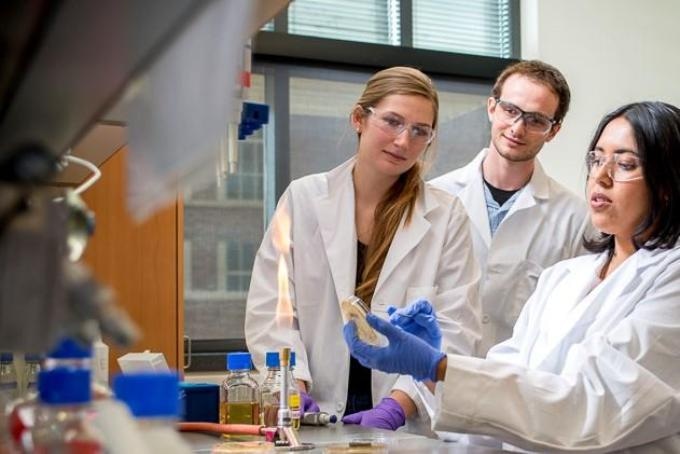Oct 5 2017
Light-activated nanoparticles, also referred to as quantum dots, can provide a vital boost in effectiveness for antibiotic treatments used to fight drug-resistant superbugs such as Salmonella and E. coli, a new CU Boulder research reveals.
 CU Boulder Researcher Colleen Courtney (left) speaks with Assistant Professor Anushree Chatterjee (right) inside a lab in the BioFrontiers Institute. (CREDIT - University of Colorado Boulder)
CU Boulder Researcher Colleen Courtney (left) speaks with Assistant Professor Anushree Chatterjee (right) inside a lab in the BioFrontiers Institute. (CREDIT - University of Colorado Boulder)
Multi-drug resistant pathogens, which evolve their defenses quicker than new antibiotic treatments can be created to treat them, cost the US an estimated $20 billion in direct healthcare costs and a further $35 billion due to lost productivity in 2013.
Researchers at CU Boulder, however, were able to re-potentiate current antibiotics for specific clinical isolate infections by launching nano-engineered quantum dots, which can be deployed selectively and triggered or de-activated using particular wavelengths of light.
Instead of fighting the infecting bacteria conventionally, the dots discharge superoxide, a chemical species that impedes with the bacteria’s cellular and metabolic processes, activating a fight response that makes it more vulnerable to the original antibiotic.
We’ve developed a one-two knockout punch. The bacteria’s natural fight reaction [to the dots] actually leaves it more vulnerable.
Prashant Nagpal, Assistant Professor and the Co-lead Author of the study, Department of Chemical and Biological Engineering (CHBE), University of Colorado Boulder
The findings, which were published on October 4th in the Science Advances journal, reveal that the dots decreased the effective antibiotic resistance of the clinical isolate infections by a factor of 1,000 without creating opposing side effects.
“We are thinking more like the bug,” said Anushree Chatterjee, an Assistant Professor in CHBE and the Co-lead author of the study. “This is a novel strategy that plays against the infection’s normal strength and catalyzes the antibiotic instead.”
While other earlier antibiotic treatments have proven too haphazard in their attack, the quantum dots have the benefit of being able to function selectively on an intracellular level. Salmonella, for instance, can grow and reproduce within host cells. The dots, however, are very small and can slip inside and help eliminate the infection from within.
“These super-resistant bugs already exist right now, especially in hospitals,” said Nagpal. “It’s just a matter of not contracting them. But they are one mutation away from becoming much more widespread infections.”
On the whole, Chatterjee said, the most significant advantage of the quantum dot technology is that it provides clinicians a flexible multifaceted method to fighting infections that are already straining the boundaries of present day treatments.
Disease works much faster than we do. Medicine needs to evolve as well.
Prashant Nagpal, Assistant Professor and the Co-lead Author of the study, Department of Chemical and Biological Engineering (CHBE), University of Colorado Boulder
In the days to cone, the research team foresees quantum dots as a kind of platform technology that can be scaled and altered to fight a broad range of infections and potentially expand to other therapeutic applications.
The new study’s Co-authors include Colleen Courtney, Max Levy, Samuel Goodman, Pallavi Bhusal of CHBE; Corrella Detweiler and Toni Nagy of the Department of Molecular, Cellular and Developmental Biology; and Nancy Madinger of CU Denver’s Division of Infectious Diseases.
To fight superbugs, researchers engineer a one-two knockout punch
Researchers at CU Boulder's BioFrontiers Institute have created light-activated nanoparticles, also known as quantum dots, which provide a crucial boost in effectiveness for antibiotic treatments used to combat drug-resistant superbugs such as E. coli and Salmonella. (CREDIT - Mason Marino / University of Colorado Boulder)